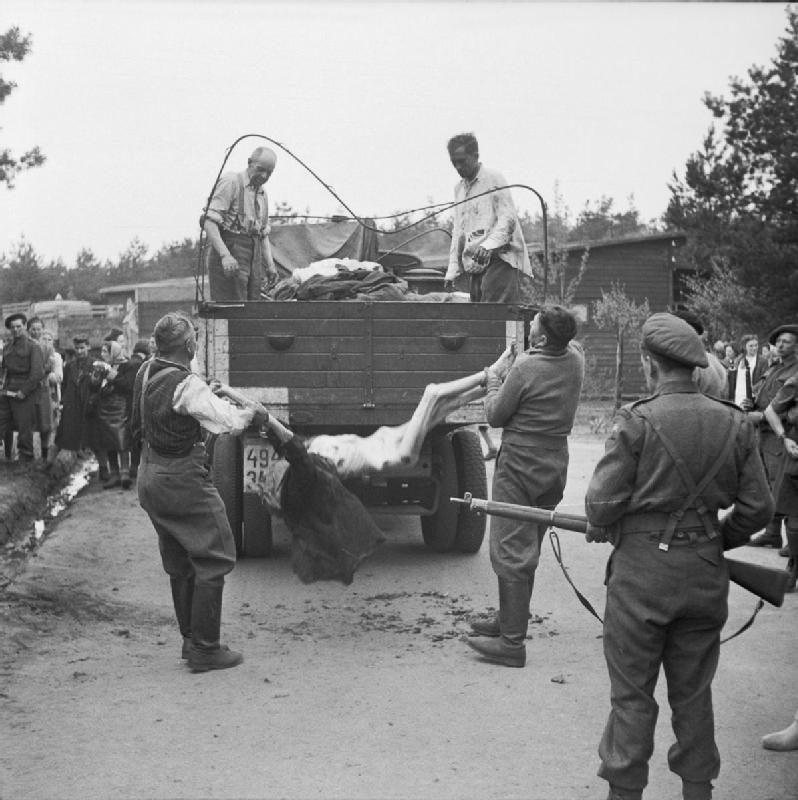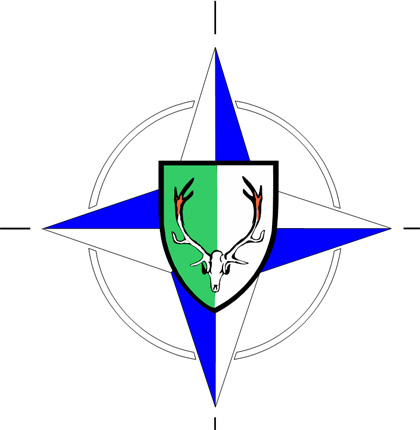|
Belsen
Bergen-Belsen , or Belsen, was a Nazi concentration camp in what is today Lower Saxony in northern Germany, southwest of the town of Bergen near Celle. Originally established as a prisoner of war camp, in 1943, parts of it became a concentration camp. Initially this was an "exchange camp", where Jewish hostages were held with the intention of exchanging them for German prisoners of war held overseas. The camp was later expanded to accommodate Jews from other concentration camps. After 1945, the name was applied to the displaced persons camp established nearby, but it is most commonly associated with the concentration camp. From 1941 to 1945, almost 20,000 Soviet prisoners of war and a further 50,000 inmates died there. Overcrowding, lack of food and poor sanitary conditions caused outbreaks of typhus, tuberculosis, typhoid fever and dysentery, leading to the deaths of more than 35,000 people in the first few months of 1945, shortly before and after the liberation. The ... [...More Info...] [...Related Items...] OR: [Wikipedia] [Google] [Baidu] |
Bergen-Belsen - 2018-02-26 (088)
Bergen-Belsen , or Belsen, was a Nazi concentration camp in what is today Lower Saxony in northern Germany, southwest of the town of Bergen near Celle. Originally established as a prisoner of war camp, in 1943, parts of it became a concentration camp. Initially this was an "exchange camp", where Jewish hostages were held with the intention of exchanging them for German prisoners of war held overseas. The camp was later expanded to accommodate Jews from other concentration camps. After 1945, the name was applied to the displaced persons camp established nearby, but it is most commonly associated with the concentration camp. From 1941 to 1945, almost 20,000 Soviet prisoners of war and a further 50,000 inmates died there. Overcrowding, lack of food and poor sanitary conditions caused outbreaks of typhus, tuberculosis, typhoid fever and dysentery, leading to the deaths of more than 35,000 people in the first few months of 1945, shortly before and after the liberation. The cam ... [...More Info...] [...Related Items...] OR: [Wikipedia] [Google] [Baidu] |
Bergen-Belsen DP Camp
Bergen-Belsen displaced persons camp was a displaced persons (DP) camp for refugees after World War II, in Lower Saxony in northwestern Germany, southwest of the town of Bergen near Celle. It was in operation from the summer of 1945 until September 1950. For a time, Belsen DP camp was the largest Jewish DP camp in Germany and the only one in the British occupation zone with an exclusively Jewish population. The camp was under British authority and overseen by the United Nations Relief and Rehabilitation Administration (UNRRA) with camp directors that included Simon Bloomberg. Today, the camp is a Bundeswehr barracks, having been a British Army base (see Hohne Station) until 2015. Location and establishment On 15 April 1945 the British Army liberated the Bergen-Belsen concentration camp, which was handed over by the SS guards without a fight. Diseases and the terrible unhygienic state of the concentration camp buildings caused the British Army to relocate the former inmates and ev ... [...More Info...] [...Related Items...] OR: [Wikipedia] [Google] [Baidu] |
Belsen (Bergen)
Belsen is a village within the German borough of Bergen in the northern part of Celle district on the Lüneburg Heath in Lower Saxony. The village, whose original site lies about southwest of Bergen, has 331 inhabitants (as at: 31 December 2000). The Belsen concentration camp was named after it. Today Belsen is dominated by the former British Army camp of Hohne (German: ''Lager Hohne'') on the edge of the NATO firing ranges. History Belsen was first mentioned in the records in 1235 under the name ''Bellenhusen''. Formerly an independent municipality, it is part of the town Bergen since 1971. Bergen-Belsen concentration camp The Bergen-Belsen concentration camp was near Belsen. The site of the former concentration camp and the present-day Bergen-Belsen Memorial Centre are mainly within the municipality of Winsen (Aller) and its parish of Walle (Winsen). Between Bergen and Belsen, there were railway ramps onto which prisoners from the incoming goods wagons alighted and from ... [...More Info...] [...Related Items...] OR: [Wikipedia] [Google] [Baidu] |
Josef Kramer
Josef Kramer (10 November 1906 – 13 December 1945) was Hauptsturmführer and the Commandant of Auschwitz-Birkenau (from 8 May 1944 to 25 November 1944) and of the Bergen-Belsen concentration camp (from December 1944 to its liberation on 15 April 1945). Dubbed the Beast of Belsen by camp inmates, he was a German Nazi war criminal, directly responsible for the deaths of thousands of people. He was detained by the British Army after the Second World War, convicted of war crimes, and hanged on the gallows in the prison at Hamelin by British executioner Albert Pierrepoint. Early life Josef Kramer, an only child, was born and raised in Munich in a middle-class family. His parents, Theodore and Maria Kramer, brought him up as a "strict Roman Catholic". In 1915, the family moved from Munich to Augsburg, where Josef Kramer attended school. He began an apprenticeship as an electrician in 1920. From 1925 to 1933, except for working in a department store and as an accountant, he was mo ... [...More Info...] [...Related Items...] OR: [Wikipedia] [Google] [Baidu] |
Anne Frank
Annelies Marie "Anne" Frank (, ; 12 June 1929 – )Research by The Anne Frank House in 2015 revealed that Frank may have died in February 1945 rather than in March, as Dutch authorities had long assumed"New research sheds new light on Anne Frank's last months". AnneFrank.org, 31 March 2015 was a Jewish girl who kept a diary in which she documented life in hiding under Nazi persecution. She is a celebrated diarist who described everyday life from her family hiding place in an Amsterdam attic. One of the most-discussed Jewish victims of the Holocaust, she gained fame posthumously with the 1947 publication of '' The Diary of a Young Girl'' (originally in Dutch, ; English: ''The Secret Annex''), in which she documents her life in hiding from 1942 to 1944, during the German occupation of the Netherlands in World War II. It is one of the world's best-known books and has been the basis for several plays and films. Anne was born in Frankfurt, Germany. In 1934, when she was four and ... [...More Info...] [...Related Items...] OR: [Wikipedia] [Google] [Baidu] |
Bergen-Hohne Training Area
Bergen-Hohne Training Area (German: ''NATO-Truppenübungsplatz Bergen'' or ''Schießplatz Bergen-Hohne'') is a NATO military training area in the southern part of the Lüneburg Heath, in the state of Lower Saxony in northern Germany. It covers an area of , which makes it the largest military training area in Germany. It was established by the German armed forces, the ''Wehrmacht'', in 1935. At the end of the Second World War it was taken over by British occupying forces and some of its facilities used as a liberation camp for survivors of the Bergen-Belsen concentration camp, which was located on the edge of the training area near the town of Bergen. Under British control, the training area was steadily expanded and, since the 1960s, has also been used by the German Armed Forces (''Bundeswehr'') and other NATO troops. Geography Location Bergen-Hohne Training Area is situated on both sides of the boundary between the districts of Heidekreis (formerly ''Soltau-Fallingboste ... [...More Info...] [...Related Items...] OR: [Wikipedia] [Google] [Baidu] |
Bergen, Lower Saxony
Bergen ( Eastphalian: ''Bargen'') is a town in the north of Celle district on the Lüneburg Heath, in Lower Saxony, Germany. Administratively it acts as a municipal borough divided into 12 subordinate parishes based on the town and its surrounding villages: Becklingen, Belsen, Bergen, Bleckmar, Diesten, Dohnsen, Eversen, Hagen, Hassel, Offen, Sülze and Wardböhmen. Bergen-Belsen concentration camp was located in the area of Belsen. The town had 13,099 inhabitants according to the census conducted in December 2008. Members of the British military and their families, who were not included in the census, brought the actual population to about 17,000. These soldiers occupied a NATO base and exercise on the Bergen-Hohne Training Area just outside the town, but the base closed in summer 2015 as part of the British Army's withdrawal from Germany. The '' Sieben Steinhäuser'', a cluster of dolmens dating from the Stone Age, are located within the training area. Geography Bergen is locat ... [...More Info...] [...Related Items...] OR: [Wikipedia] [Google] [Baidu] |
Margot Frank
Margot Betti Frank (16 February 1926 – ) was the elder daughter of Otto Frank and Edith Frank and the elder sister of Anne Frank. Margot's deportation order from the Gestapo hastened the Frank family into hiding. According to the diary of her younger sister, Anne, Margot kept a diary of her own, but no trace of it has ever been found. She died in Bergen-Belsen concentration camp. Early life and education Margot Betti Frank, named after her maternal aunt Bettina Holländer (1898–1914), was born in Frankfurt and lived in the outer suburbs of the city with her parents, Otto Frank and Edith Frank-Holländer, and also her younger sister Anne Frank. Edith and Otto were devoted parents who were interested in scholarly pursuits and had an extensive library; they encouraged the children to read. At the time her sister Anne was born, the family lived in a house at Marbachweg 307 in Frankfurt- Dornbusch, where they rented two floors. Margot and Anne played almost every day in th ... [...More Info...] [...Related Items...] OR: [Wikipedia] [Google] [Baidu] |
Celle
Celle () is a town and capital of the district of Celle, in Lower Saxony, Germany. The town is situated on the banks of the river Aller, a tributary of the Weser, and has a population of about 71,000. Celle is the southern gateway to the Lüneburg Heath, has a castle (''Schloss Celle'') built in the Renaissance and Baroque style and a picturesque old town centre (the ''Altstadt'') with over 400 timber-framed houses, making Celle one of the most remarkable members of the German Timber-Frame Road. From 1378 to 1705, Celle was the official residence of the Lüneburg branch of the dukes of Brunswick-Lüneburg (House of Welf) who had been banished from their original ducal seat by its townsfolk. Geography The town of Celle lies in the glacial valley of the Aller, about northeast of Hanover, northwest of Brunswick and south of Hamburg. With 71,000 inhabitants it is, next to Lüneburg, the largest Lower Saxon town between Hanover and Hamburg. Expansion The town cove ... [...More Info...] [...Related Items...] OR: [Wikipedia] [Google] [Baidu] |
Stalag XI-C
Stalag XI-C Bergen-Belsen, initially called Stalag 311, was a German Army prisoner-of-war camp located near the town of Bergen in Lower Saxony. Timeline * May 1940: The camp was built to house Belgian and French enlisted men captured in the Battle of France; initial count: 600. * July 1941: About 20,000 Soviet prisoners captured during Operation Barbarossa arrived. They were housed in the open while huts were being built. By the spring of 1942 an estimated 18,000 had died of hunger and disease, mainly typhus fever. * April 1943: Part of the camp is turned into a hospital for POWs. The remainder of the camp is separated and taken over by the SS to house Jews ostensibly for shipment overseas in exchange for German civilians. * Late 1943: The POW camp is closed and the entire facility becomes Bergen-Belsen concentration camp See also * Nazi concentration camps From 1933 to 1945, Nazi Germany operated more than a thousand concentration camps, (officially) or (more commonly) ... [...More Info...] [...Related Items...] OR: [Wikipedia] [Google] [Baidu] |
11th Armoured Division (United Kingdom)
The 11th Armoured Division was an armoured division of the British Army which was created in March 1941 during the World War II, Second World War. The division was formed in response to the unanticipated success of the German panzer divisions. The 11th Armoured was responsible for several major victories in the Operation Overlord, Battle of Normandy from in the summer of 1944, shortly after the Normandy landings, and it participated in the Allied advance from Paris to the Rhine, the Operation Plunder, Rhine crossing in March 1945. It was disbanded in January 1946 and reformed towards the end of 1950. In 1956, it was converted into the 4th Infantry Division (United Kingdom), 4th Infantry Division. Background and formation The 11th Armoured Division was organized in March 1941, in Yorkshire under Northern Command (United Kingdom), Northern Command, under Major-General Percy Hobart. A veteran of the Royal Tank Regiment, he had already strongly influenced the shape of the 7th Armo ... [...More Info...] [...Related Items...] OR: [Wikipedia] [Google] [Baidu] |
Nazi Concentration Camp
From 1933 to 1945, Nazi Germany operated more than a thousand concentration camps, (officially) or (more commonly). The Nazi concentration camps are distinguished from other types of Nazi camps such as forced-labor camps, as well as concentration camps operated by Germany's allies. on its own territory and in parts of German-occupied Europe. The first camps were established in March 1933 immediately after Adolf Hitler became Chancellor of Germany. Following the 1934 purge of the SA, the concentration camps were run exclusively by the SS via the Concentration Camps Inspectorate and later the SS Main Economic and Administrative Office. Initially, most prisoners were members of the Communist Party of Germany, but as time went on different groups were arrested, including "habitual criminals", "asocials", and Jews. After the beginning of World War II, people from German-occupied Europe were imprisoned in the concentration camps. Following Allied military victories, the ... [...More Info...] [...Related Items...] OR: [Wikipedia] [Google] [Baidu] |
.jpg)








